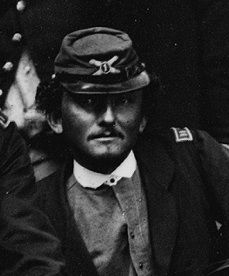William Montrose Graham Jr. facts for kids
Quick facts for kids
William Montrose Graham Jr.
|
|
|---|---|

Captain William Montrose Graham Jr., September 1863. Library of Congress.
|
|
| Born | September 28, 1834 Washington, D.C. |
| Died | January 16, 1916 (aged 81) Wardour, Maryland |
| Place of burial |
Congressional Cemetery
|
| Allegiance | United States of America Union |
| Service/ |
United States Army Union Army |
| Years of service | 1855–1898 |
| Rank | |
| Commands held | 2nd District of Columbia Infantry 5th Artillery Regiment Second Army Corps |
| Battles/wars | American Civil War |
| Signature | |
William Montrose Graham Jr. (September 28, 1834 – January 16, 1916) was a professional soldier in the United States Army. He rose to the high rank of major general. He bravely served in two major conflicts: the American Civil War and the Spanish–American War.
Contents
Early Life and Family Connections
William Montrose Graham Jr. was born in Washington, D.C.. His father, James Duncan Graham, was a colonel in the army. William's mother, Charlotte Meade, was the sister of the famous Civil War general, George Gordon Meade.
William also had an uncle named William Montrose Graham. This uncle, who was his namesake, was killed in 1847 during the Mexican–American War. He was leading the 11th U.S. Infantry at the Battle of Molino del Rey.
A Career in the Army
William Montrose Graham Jr. joined the army in 1855. He started his career in the 1st Regiment of Artillery. When the Civil War began, he quickly earned two promotions, becoming a captain.
Bravery in the Civil War
During the American Civil War, Graham showed great courage. He was recognized for his brave actions in several important battles:
- The Peninsula Campaign
- The Battle of Antietam
- The Battle of Gettysburg
For his bravery, Graham received several honorary promotions, called brevet promotions. These included:
- Major (July 1, 1862) for his actions at Malvern Hill.
- Lieutenant Colonel (September 17, 1862) for Antietam.
- Colonel (July 3, 1863) for Gettysburg.
From 1863, his unit, the 1st U.S. Light Artillery, Battery K, was part of the famous U.S. Horse Artillery Brigade.
After the Civil War
Graham continued to serve in the Regular Army after the Civil War ended. In April 1865, he became a colonel of the 2nd District of Columbia Infantry Regiment. He received his final brevet promotion of the war to brigadier general in the Regular Army.
He left the volunteer service in September 1865 and returned to his regular army duties. He served with the 4th and 5th Artillery regiments. On May 26, 1897, he was promoted to brigadier general in the Regular Army.
The Spanish-American War
In May 1898, when the Spanish–American War began, Graham was promoted to major general of U.S. Volunteers. He briefly commanded the Second Army Corps at Camp Alger and Camp Meade.
On his 64th birthday, he retired from the Regular Army. He was honorably discharged from the volunteers on November 30, 1898. In 1898, he also became a member of the Pennsylvania Commandery of the Military Order of Foreign Wars.
William Montrose Graham Jr. passed away in Wardour, Maryland, on January 16, 1916. He was buried at Congressional Cemetery in Washington, D.C.
Family Life
In 1860, William Montrose Graham Jr. married Mary Brewerton Ricketts. She was the daughter of Major General James Brewerton Ricketts. Mary was originally named Aroostine to honor her Native American background. Her family later changed her name legally to Mary.
William and Mary (Aroostine) had six children. Some of their notable children included:
- Mary Ricketts Graham, who married Vice Admiral Guy Hamilton Burrage.
- Meeta Campbell Graham, who married Carroll Storrs Alden. He was a department head at the US Naval Academy and wrote books about naval history.
- Harriet Pierce Graham, who married Rear Admiral Archibald Henderson Scales. He was also a Superintendent of the US Naval Academy.
- Lieut William Montrose Graham.
Images for kids

